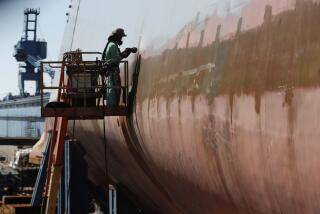Radar-evading Navy ship for sale in public auction
- Share via
For sale: An exotic, once top-secret radar-evading ship, dubbed the Sea Shadow, that was built by one of the world’s largest defense contractors during the height of the Cold War.
Specifications: about 68 feet wide, 164 feet long and around 563 tons.
Price: $139,200 or best offer.
If interested, please contact the General Services Administration at its website: gsaauctions.gov.
That’s the sales pitch from theU.S. Navy, which — after five years of trying and failing to donate the stealthy Sea Shadow to a museum — is now selling the ship for scrap metal in an online auction. All bids must be in at 3 p.m. Pacific time Friday.
But there’s a catch. To win the auction, the successful bidder must agree to dismantle and scrap the Sea Shadow within six months — and not keep it for a Sunday sail. Perhaps that’s why as of Wednesday afternoon, there were only 10 bids made — the highest being $139,100.
The sinister-looking ship, which when viewed straight on looks like Darth Vader’s menacing black mask, was designed by Lockheed Corp. at its famed Skunk Works facility in Burbank to baffle enemy radars as it slithered through the seas on night missions.
The Navy, which took delivery of the vessel in 1985, is ready to let it go.
“It is not cost effective for the Navy to maintain the ship in an inactive condition any longer, and the ship no longer serves any operational or research purpose,” said Navy spokesman Christopher Johnson. “Our only disposition option is dismantling and recycling.”
First designed by Skunk Works engineers, the Sea Shadow was built inside a massive barge in Redwood City, Calif., so it wouldn’t be exposed to orbiting Soviet spy satellites.
The vessel was built under tight secrecy through the combined efforts of Lockheed, the Navy and the Defense Advanced Research Projects Agency, or DARPA. The Sea Shadow cost about $50 million to build, and the total cost of the program over 10 years was about $195 million, according to GlobalSecurity.org, a website for military policy research.
It was never intended for combat, so it was never designated as “USS,” the Navy said. Rather, the Sea Shadow was an experimental ship to test military hardware.
“It was an important proving ground for technologies in automated ship control, advanced structures, crew reduction, sea keeping and stealth,” said Melissa Dalton, spokeswoman forLockheed Martin Corp.”Sea Shadow’s angular hull — reminiscent of Lockheed Martin’s F-117 fighter jet — demonstrated that ships could reduce their radar signatures.”
The Sea Shadow’s strange shape deflects radar waves in various directions.
The angled sides also help the ship remain stable in very rough water, which is key because the Sea Shadow sits in the water like a catamaran and doesn’t have traditional rudders to steer it. Diesel-electric engines attached to the submerged twin hulls help control steering.
The vessel doesn’t have much room for a large crew. It had only 12 bunks, one microwave oven, a refrigerator and a table.
The Navy said that most of the people involved with the ship have long since retired and details on the ship’s operational history remain classified.
A few details were revealed by Ben Rich in his book “Skunk Works.” As former head of the Lockheed facility, he disclosed that in order to test the ship, Lockheed and the Navy cocooned the ship in the barge and tugged it at night down to Long Beach, where it was tested offshore.
During tests, the Navy would open the barge and allow the Sea Shadow to creep into the open sea, Rich wrote. Then a fleet of submarine-hunting airplanes would zoom overhead and send down radar waves in an effort to detect the ship.
“On a typical night of testing, the Navy sub-hunter planes made 57 passes at us and detected the ship only twice,” he wrote. “A typical warship was a very high reflector of radar — a radar profile equal to about fifty barns. Our frigate would show up a hell of a lot smaller than a dinghy.”
After years of being hidden from public view, the ship was put on display for the first time in 1993 and moved around various naval bases. In 2006, the Sea Shadow was removed from service and relocated to Suisun Bay near the San Francisco Bay Area town of Benicia. For years, the government tried to find a home in a museum but was unsuccessful.
“I am amazed that it’s up for auction and a museum didn’t take it,” said Sherm Mullin, retired head of Lockheed’s Skunk Works. “But when I stop to think about it for about 10 microseconds, it becomes apparent to me that ships are difficult to take care of — a lot more difficult than airplanes.”
For now, the Sea Shadow, along with its massive barge built by reclusive billionaire Howard Hughes’ Hughes Mining Corp., awaits Friday’s online auction deadline to determine its fate.
More to Read
Inside the business of entertainment
The Wide Shot brings you news, analysis and insights on everything from streaming wars to production — and what it all means for the future.
You may occasionally receive promotional content from the Los Angeles Times.











